GDevelop interface
The working interface of GDevelop is based on editors that are displayed in tabs. These editors allow you to change different parts of your game.

Home Page
The Home Page is displayed when you first launch GDevelop. From the Home Page you can create your projects, load previously saved projects, or load tutorials.

At startup, GDevelop will check for new updates. If a new update is available, the update will automatically be downloaded (unless deactivated in preferences).
You can see the progress by clicking on About GDevelop.
Project Manager
When a project is opened, you can click on the top-left button to access to the project manager.

The project manager shows the structure of your game:

Using the project manager, you can add new elements to your game and open editors. Learn more about the content of the project manager here.
Scene editor
When opening a scene (or an external layout), the scene editor associated with that scene opens. This is where you can design and build your game levels and menus by creating and adding objects to the scene. The first scene in the list is the first scene loaded when the game is launched.
Learn more about using scene editors.
Events editor
When opening a scene (or when opening external events), the events editor associated with that scene is also opened. This is where you set up your game's logic, using GDevelop's visual no-code system to program your game without any specific programming knowledge or experience.
Learn more about its usage on this page or check the help about events.
Top menu
The menu at the top left corner of the screen allows you to open, save, and publish a game.
You can also open GDevelop preferences or see the profile associated with your GDevelop account.

Interface Themes
You can choose a different theme for the interface, according to your taste. To change the theme, navigate to File->Preferences.
See, preferences
You can also create themes of your own to use and share. Learn more about creating a theme here.